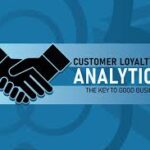In today’s highly competitive business environment, retaining customers is just as important as acquiring new ones. Companies that invest in customer loyalty analytics can gain valuable insights into consumer behavior, preferences, and engagement patterns, allowing them to develop targeted strategies that enhance customer retention and boost long-term profitability.
By leveraging customer loyalty analytics, businesses can measure the effectiveness of their loyalty programs, personalize customer interactions, and optimize marketing efforts. This article explores the significance of customer loyalty analytics, its benefits, key metrics, and best practices for implementing an effective analytics-driven loyalty strategy.
What is Customer Loyalty Analytics?
Customer loyalty analytics refers to the process of collecting, analyzing, and interpreting data related to customer engagement, repeat purchases, and brand interactions. Businesses use this data to evaluate the performance of their loyalty programs, understand customer motivations, and enhance their retention strategies.
By utilizing advanced analytics tools, machine learning, and predictive modeling, companies can identify patterns and trends that influence customer loyalty. This enables them to make data-driven decisions that improve customer satisfaction and drive revenue growth.
Benefits of Customer Loyalty Analytics
- Improved Customer Retention
Understanding what keeps customers loyal allows businesses to develop strategies that encourage repeat purchases and long-term relationships. With customer loyalty analytics, companies can identify at-risk customers and take proactive measures to retain them. - Enhanced Personalization
Data-driven insights from customer loyalty analytics enable businesses to offer personalized recommendations, exclusive rewards, and customized marketing messages. This increases customer satisfaction and strengthens brand loyalty. - Optimized Loyalty Programs
Many businesses struggle to determine whether their loyalty programs are effective. Customer loyalty analytics helps measure program success, identify areas for improvement, and refine rewards to maximize engagement. - Higher Customer Lifetime Value (CLV)
By analyzing customer behavior and purchase history, businesses can identify high-value customers and implement strategies to increase their lifetime value. This leads to higher profitability and long-term success. - Better Marketing ROI
Customer loyalty analytics provides insights into which marketing campaigns and incentives drive the most engagement. Businesses can allocate their budgets more effectively and focus on strategies that yield the highest return on investment.
Key Metrics in Customer Loyalty Analytics
- Customer Retention Rate (CRR)
This metric measures the percentage of customers who continue to do business with a company over a specific period. A high retention rate indicates strong customer loyalty. - Net Promoter Score (NPS)
NPS measures customer satisfaction and loyalty by asking customers how likely they are to recommend the brand to others. A high NPS score indicates strong brand advocacy. - Customer Lifetime Value (CLV)
CLV calculates the total revenue a business can expect from a customer over their lifetime. Higher CLV means customers are making repeat purchases and engaging with the brand consistently. - Churn Rate
The churn rate indicates the percentage of customers who stop doing business with a company. Customer loyalty analytics helps identify churn reasons and implement retention strategies. - Redemption Rate
This metric measures how often customers redeem rewards in a loyalty program. A low redemption rate may indicate that customers do not find the rewards valuable. - Engagement Rate
Businesses track engagement across different channels, including email campaigns, social media, and in-app interactions. High engagement suggests that customers are actively interacting with the brand.
Best Practices for Implementing Customer Loyalty Analytics
- Integrate Data from Multiple Sources
Collect data from various customer touchpoints, including POS systems, mobile apps, websites, and social media, to get a holistic view of customer behavior. - Use AI and Predictive Analytics
Machine learning and predictive analytics can identify patterns in customer behavior, helping businesses anticipate needs and tailor their loyalty strategies accordingly. - Segment Customers for Personalized Rewards
Use customer loyalty analytics to segment customers based on purchase history, behavior, and preferences. This enables businesses to offer targeted incentives that resonate with different customer groups. - Monitor and Optimize Loyalty Programs Regularly
Businesses should continuously track the performance of their loyalty programs and make data-driven adjustments to improve engagement and redemption rates. - Encourage Customer Feedback
Gathering feedback through surveys and online reviews helps businesses understand customer expectations and refine their loyalty programs. - Implement Gamification Strategies
Adding gamification elements, such as point-based challenges, leaderboards, and exclusive rewards, can enhance customer engagement and loyalty.
Tools for Customer Loyalty Analytics
- Google Analytics
Helps track website and mobile app engagement, providing insights into customer behavior and retention. - Salesforce Customer Analytics
Offers AI-driven insights to analyze customer interactions and optimize loyalty strategies. - Adobe Analytics
Provides real-time data and predictive analytics to improve customer engagement and retention. - Loyalty Program Software (e.g., Smile.io, LoyaltyLion, FiveStars)
These platforms help businesses design and manage loyalty programs while providing analytics on customer participation and engagement. - Tableau
A powerful data visualization tool that enables businesses to interpret complex customer loyalty analytics data effectively.
Conclusion
Customer loyalty analytics is a powerful tool for businesses looking to enhance retention, increase engagement, and drive long-term growth. By leveraging data-driven insights, companies can optimize their loyalty programs, personalize customer interactions, and improve overall customer satisfaction.
With the right analytics tools and strategies, businesses can maximize customer lifetime value, boost marketing efficiency, and stay ahead in an increasingly competitive market. Investing in customer loyalty analytics is no longer an option—it’s a necessity for businesses aiming for sustainable growth and customer success.

